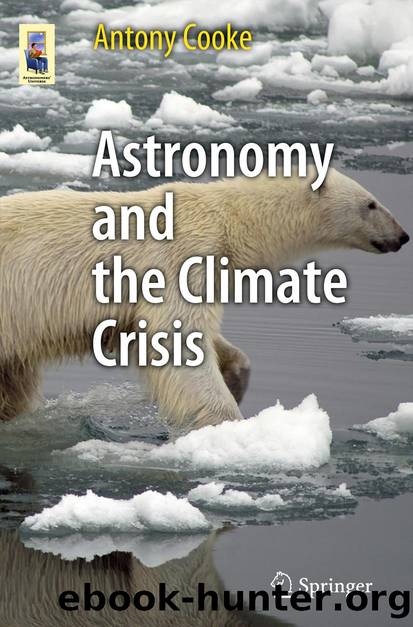Astronomy and the Climate Crisis by Antony Cooke

Author:Antony Cooke
Language: eng
Format: epub
Publisher: Springer New York, New York, NY
There are limitations to what we can infer, of course, imposed on us by the relatively short time scale of accurate record keeping. However, the 60-year cycle does seem clearly evident on the Hadley chart (approximately 1880–1940 and 1940–2000) and contained within an overall upward temperature trend. It is not always so clearly revealed on many other graphs. The El Nino ‘spike’ of 1997/1998 is quite clear and draws our attention to similar ‘spikes’ at near comparable times in previous 60-year patterns. Historically, a strong El Nino event was registered in 1946, right in line with the highest such ‘spike.’ Similarly, as if right on cue with the previous high mark, there was a notable increase of El Nino events in the late 1870s, corresponding with a period of extreme drought and famine in Asia at the time.
If we accept the possibility of a 60-year or so cycle, it would appear that in 2011 we are occupying the downside of the last such cycle, and might thus be seeing possibly the first clear stages of a decline in warming. The full down and up cycle will bring us to about 2060. Although the overall approximate 1°C climate warming throughout most of the preceding twentieth century is not an item of controversy, we can see that this is also clearly shown on the graph by its continual upward trend.
Researchers and their theories concerning the 60-year cycle are numerous, but among those who have inferred its existence include the following: Timo Niroma made explicit mention of such links in publications on his personal website [8]. He paralleled the larger historical periods of sunspot activity (or lack thereof) that coincide with the 60-year cycles of temperature. As he saw it, the 60-year timings are dead on, although they do not necessarily alternate in sequence. There often can be more than one cold or warming cycle in a row. He even listed the dates through the past 400 years that correspond to solar cycles; certainly these do seem to approximate the known record.
Download
This site does not store any files on its server. We only index and link to content provided by other sites. Please contact the content providers to delete copyright contents if any and email us, we'll remove relevant links or contents immediately.
| Aeronautics & Astronautics | Astronomy |
| Astrophysics & Space Science | Comets, Meteors & Asteroids |
| Cosmology | Mars |
| Solar System | Star-Gazing |
| Telescopes | UFOs |
Tools of Titans by Timothy Ferriss(8214)
Turbulence by E. J. Noyes(7935)
Secrets of Antigravity Propulsion: Tesla, UFOs, and Classified Aerospace Technology by Ph.D. Paul A. Laviolette(5309)
Astrophysics for People in a Hurry by Neil DeGrasse Tyson(5130)
Room 212 by Kate Stewart(5035)
Design of Trajectory Optimization Approach for Space Maneuver Vehicle Skip Entry Problems by Runqi Chai & Al Savvaris & Antonios Tsourdos & Senchun Chai(5011)
Pale Blue Dot by Carl Sagan(4907)
The David Icke Guide to the Global Conspiracy (and how to end it) by David Icke(4624)
A Journey Through Divination and Astronomy by Publishing Pottermore(4341)
Goodbye Paradise(3724)
Apollo 8 by Jeffrey Kluger(3635)
COSMOS by Carl Sagan(3553)
Losing the Nobel Prize by Brian Keating(3498)
The Five People You Meet in Heaven by Mitch Albom(3474)
How to Read Water: Clues and Patterns from Puddles to the Sea (Natural Navigation) by Tristan Gooley(3406)
Brief Answers to the Big Questions by Stephen Hawking(3369)
How to Read Nature by Tristan Gooley(3249)
The Order of Time by Carlo Rovelli(3144)
A Brief History of Time by Stephen Hawking(2959)
